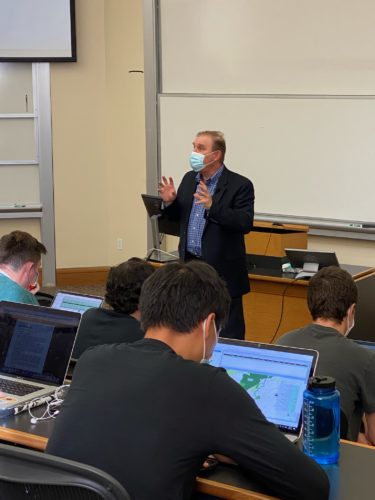Stanford Law Students Offer Model Redistricting Plans to Help Redraw Congress
A Stanford Law Policy Lab responds to once-in-a-decade opportunity to help ensure fair representation
Redistricting in the United States is a legally required process of drawing new congressional and state legislative district boundaries to account for population shifts. Most redistricting takes place every 10 years, shortly after the release of the decennial U.S. census, and is conducted by state legislatures.
While many believe redistricting should be based on non-partisan principles (such as creating compact districts, uniting communities of interest, respecting municipal boundaries, maximizing competition or achieving proportional representation), these principles do not always drive many redistricting plans. In many states, the state legislature draws districts in order to influence the makeup of the legislature for partisan reasons, discourage electoral competition or protect the incumbents. Due to past gerrymandering and redistricting lawsuits, civic groups have engaged in ongoing efforts to reform redistricting laws, including to remove redistricting from state legislatures. In recent years, for example, states such as California and Arizona have appointed bi-partisan or independent redistricting commissions to draw new district maps.
Re-drawing congress
Draw Congress, a project developed under Stanford Law School’s Law and Policy Lab, is one of many efforts currently underway to influence or reform redistricting. Sixteen law students and six Stanford undergraduate students are participating in a crash course on the difficult process of drawing congressional maps that align with the 2020 U.S. Census. The initiative is led by renowned voting expert, Professor Nate Persily, the James B. McClatchy Professor of Law at Stanford. Persily was commissioned to redraw district lines for Georgia, Maryland, New York, Connecticut, North Carolina, and Pennsylvania in the past and has served as a legal expert for many courts and redistricting commissions.
“The goal of this project is to educate our students and the general public about this difficult and sometimes fraught undertaking, showing how districts can be drawn in a non-partisan, legally defensible manner,” said Persily. “We hope our maps, eventually made for all 435 U.S. House districts, will show how communities can be fairly represented and, unlike most incumbent-drawn maps, be transparent about redistricting decisions.”
A product of the Stanford Redistricting Project, the Draw Congress website (drawcongress.org) provides access to student-drawn redistricting plans inspired by traditional principles of redistricting (e.g. good government, proportional representation, max competition, community of interest, least change, etc.). The website includes a map of the United States with links to each state’s redistricting plans developed by students. The plans reveal the author and indicate the redistricting principles that he/she prioritized in the development of the map, along with a plan description, detailed data, images and resources used to create the plan.
“The Stanford Redistricting Project explores the core democratic principle of fair representation in government,” said Zahavah Levine, staff director of the project. “The Supreme Court’s decision in Rucho v. Common Cause (2019), which held that federal courts won’t consider constitutional challenges to partisan gerrymanders, increases the importance of public involvement in the redistricting process. This project is part of reinvigorating public participation in that process.”
“We are making these student-created plans publicly available during this critical period in the redistricting process so that they can serve as a benchmark against which incumbent-drawn plans can be assessed,” said Levine. “We hope that interested members of the public and press will consider these maps when evaluating those proposed in their own states.”
Once-in-a-decade opportunity to insure free and fair elections
Dakota Foster, JD ‘23, signed up as soon as she could for the redistricting project. “One big motivation for me getting involved was voting rights and questions of representation…we need to make sure that everyone has representation and an equal voice, an equal vote. That seems more important than ever.”

The policy lab students meet with Persily to review their plans and discuss the techniques and principles used to redraw districts and create their plans. The students draw their maps using software called Maptitude for Redistricting by Caliper Corporation. All maps and associated data uploaded to drawcongress.org can be exported and freely used by anyone. Accompanying each plan are GeoJSON and block equivalency files that will allow courts, legislators, and journalists to recreate the plans for real world applications.
“By discussing how to keep certain communities together, and making sure not to dilute the votes of certain groups, we are showcasing how we can end up with nonpartisan maps through this process, which could impact the national discussion on redistricting,” said Sajan Mehrotra, BS ’23, a Stanford undergraduate student who signed up for the project at the law school. “That is pretty cool.”
Currently, students have uploaded 65 redistricting plans for 39 states and will continue to add more in the weeks and months to come. In addition, the Draw Congress website points to third-party websites that provide helpful redistricting resources and tools for members of the public to draw redistricting plans, such as Redistrict2020, Districtr, and Dave’s Redistricting.The website will be shared with civic organizations that focus on redistricting and the policy lab students can also submit their maps to redistricting commissions.
Draw Congress also provides an extensive list of helpful, non-partisan resources that can help anyone learn about, follow, and practice redistricting. To further explore the project, visit www.drawcongress.org.
“This is a really unique opportunity…to know that, even as a law student when you’re not in the most powerful position, you’re able to contribute to [a voting rights] effort,” said Foster.

